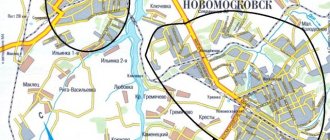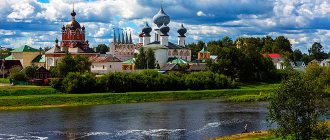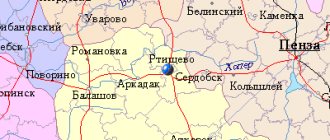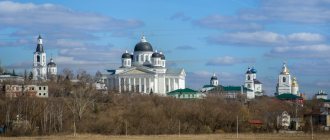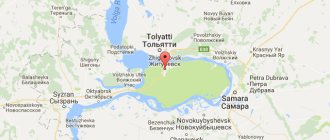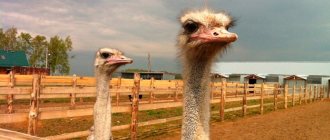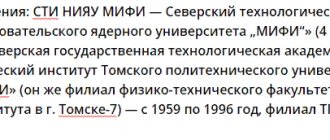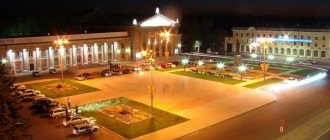| city of regional subordination with administrative territory[1] / urban district[2] | |
| Kolomna urban district | |
| Flag | Coat of arms |
This term has other meanings, see Kolomna.
Kolomna urban district
- a municipal entity in the Moscow region of Russia. It has existed within modern borders since October 6, 2022[4]. At the level of administrative-territorial structure, it corresponds to the city of regional subordination of Kolomna with its administrative territory[5].
The administrative center is the city of Kolomna.
History[ | ]
See also: Kolomenskoye Principality, History of Kolomensky Uyezd and History of Kolomensky District
On November 25, 2004, by law of the Moscow region No. 153/2004-OZ, the city of regional subordination of Kolomna was given the status of an urban district[6].
On April 6, 2022, the Kolomna urban district and the Kolomna municipal district were merged into the Kolomna urban district[7].
On July 8, 2022, the administrative-territorial Kolomna district was abolished and transformed into the city of regional subordination of Kolomna with the administrative territory
[5][8].
On October 6, 2022, the Kolomna urban district and the Ozyory urban district were merged, the newly formed urban district received the official name Kolomna Urban District
[4].
On November 5, 2022, rural settlements subordinate to Ozyory were subordinated to Kolomna[9].
The law of December 9, 2022 changed the category of the city of Ozyory to the category of a city administratively subordinate to the city of regional significance of Kolomna[10][11].
Kolomna
The emergence of the city
The official founding date of the city in Russian historiography is considered to be 1177, in which Kolomna was first mentioned in the Laurentian Chronicle as an existing outpost of the Ryazan principality at the crossroads of waterways - the Kolomenka, Moscow and Oka rivers.
However, archaeological evidence suggests that the area has been inhabited since ancient times. Primitive sites dating back to the 7th–6th millennium BC were discovered at the confluence of the Kolomenka and Moscow rivers. The finds of permanent settlements of Finno-Ugric tribes, the so-called Dyakovo culture, date back to the early Iron Age, approximately to the second half of the 1st millennium BC. The Slavic tribes of the Vyatichi came to these lands much later, in the 7th–8th centuries. AD and founded the first small settlement on the territory of today's Kolomna Kremlin. This nation was engaged in agriculture and modified the landscape, conquering land for arable land from the pine forest and smoothing out the ravine river bank.
In the 11th–12th centuries, the territory of present-day Kolomna fell into the sphere of interests of the Ryazan princes. At that moment, the modern Moscow region became an arena of confrontation between numerous small independent principalities. The settlement, located at the mouth of the Moscow River and, thanks to its favorable geographical location, was a kind of gateway to the Volga-Oka basin, became one of the most tasty morsels. According to the dating of archaeological artifacts, the Ryazan people began active construction of a new settlement between 1140 and 1160, trying to turn it into a border security post of their principality. The village preceding Kolomna was gradually absorbed by the fortified fortress.
The strategic position of the city at the intersection of trade routes to the Volga contributed to the development of crafts, the growth of prosperity and the rapid separation of Kolomna into a separate principality within the Ryazan lands. It was in this capacity that the city was first named in chronicle sources.
Historical evidence about the rulers of the Kolomna appanage is quite limited. It is known for certain that the Vladimir prince Vsevolod the Big Nest actively intervened in the dynastic politics of the Ryazan principality in the 1180s and helped his Ryazan protégé, Prince Vsevolod Glebovich, gain a foothold in Kolomna and Pronsk. After 1238, the title of Prince of Kolomna no longer appears in chronicles. There was a continuous struggle for the Kolomna fortress between the rival princes of Vladimir and Ryazan, but in the end it went to the Moscow principality, which strengthened its position in 1301.
origin of name
Several scientific hypotheses and folk lexical associations have arisen around the etymology of Kolomna over the centuries.
The most scientifically based versions refer us to the Ryazan concept of kolomenye, used to designate a border or border point. Other researchers see in the name of the city a compound lexeme based on words of Finno-Ugric origin: koi - fish and kolva - river. This version is supported by the ancient spelling of the hydronym Kolomna as Kopalnaya. The assumption of the historian Simeon of Pisemsky also goes back to the trajectory formed by three rivers, which seem to border the city. A similar version claims that the name goes back to the phrase “Oka Broken,” reflecting the characteristics of the river’s flow. The hydronym Kolomna is found in other regions of Rus' and is possibly related to Ukrainian and Polish words meaning “deep ruts filled with water.”
There are also folk etymological versions that connect the name of the city with the occupations of the townspeople, for example, with the words “menok” (market), “quarry”. And the version, which is completely far from reality, derives its name from the Latin “columna” - column. Its appearance is sometimes associated with the wild imagination of the herald master of Peter I, Count Santi, who was entrusted with the creation of the coat of arms of Kolomna (see below).
Medieval Kolomna
At the very beginning of the 14th century, the youngest son of Alexander Nevsky, Daniil Alexandrovich (1261–1303), after a successful military campaign against Ryazan, annexed Kolomna to his possessions. This acquisition was the first step in a long process of gathering lands around the growing Moscow principality. From that moment on, Kolomna took a strong position among the cities handed down by spiritual charter to the heirs of the Moscow throne. Through Ivan Kalita and Semyon the Proud, Kolomna directly passed in 1358 under the rule of Dmitry Donskoy (1350–1389). At that time, the city flourished as a trade center and even became the center of a diocese established in the same year. Local bishops enjoyed the special favor and generosity of Moscow princes throughout the 14th and 15th centuries, since the latter were in dire need of clergy to defend their secular interests in the Church.
Kolomna, which guarded the southern approaches to Moscow, often witnessed turning points in the relationship between Rus' and the Horde. In 1380, it was near Kolomna that Dmitry Donskoy gathered his troops for the last review before the famous Battle of Kulikovo. But, unfortunately, the city had to become a victim of all the destructive campaigns of the Tatar-Mongols against Rus' in 1238 (Batu), 1293 (Dudenev's army), 1382 (Tokhtamysh) and 1408 (Edigei). Kolomna was destroyed to the ground, but it invariably rose from the ashes and was rebuilt.
After the invasion of Khan Tokhtamysh, who was avenging the defeat on the Kulikovo field, Kolomna was unexpectedly invaded in 1385, taking advantage of the general confusion and weakening of Moscow, by the Ryazan prince Oleg (? - 1402). The return of the city to the bosom of the Moscow state was facilitated by the diplomatic talent of Sergius of Radonezh, and peace between the princes was restored in 1387 and secured by the marriage of their children.
The economic growth of Kolomna contributed to its advancement among Russian cities and even made it a rival of Moscow at certain historical moments. Thus, during the internecine feud between the heirs of Dmitry Donskoy in 1425–1453, Kolomna first became the place of exile of Vasily II the Dark, and then the concentration of forces opposed to Yuri of Zvenigorod, who briefly reigned on the grand-ducal throne in Moscow. Numerous supporters of Vasily the Dark flocked to Kolomna in the 1430s, turning it for a short historical moment into an alternative capital of Rus'. After the defeat of Yuri Zvenigorodsky’s party, his son, the rebellious Dmitry Yuryevich Shemyaka, an odious and dark figure on the political scene, ended up in exile in Kolomna. Later, Kolomna became a place of honorable exile for Novgorod and Pskov residents who opposed the annexation of their lands to the Moscow state. These settlers contributed greatly to the formation of the merchant class in Kolomna.
In the 15th–16th centuries, under the walls of Kolomna, an enemy from the south appeared more than once in the person of the last Golden Horde khans and Crimean Tatars. In 1472, near the city, the troops of Tsar Ivan III repelled the attack of Khan Akhmat, thus closing the era of Rus''s political dependence on the Horde. Nevertheless, Kolomna still had to stand against the invaders, and in 1521 and 1571 the city was destroyed by the Crimean khans from the Girey family. In the interval between these devastating raids, stone urban planning was launched in the city by order of Vasily III. In 1521–1531, the Kolomna Kremlin was expanded and significantly strengthened, becoming a formidable outpost of 17 towers on the southern borders of the Moscow state. More and more people flocked to the protection of its mighty walls, and by the end of the 15th century the population increased several times. Crowded settlements grew up around the impregnable Kolomna Kremlin.
In the second half of the 16th century, the heir of Vasily III, Ivan the Terrible, established a bridgehead in Kolomna for his troops, from which they launched campaigns against the Kazan Khanate. The first three attempts were unsuccessful, but in 1552, luck finally smiled on the tsar: Kazan fell and the 150,000-strong Russian army returned to Kolomna, crowned with the glory of the victors. In memory of the capture of Kazan, the Brusensky Monastery was erected in the city. In addition, Ivan IV often visited Kolomna in connection with the threat of an attack by the Crimean Tatars, but during his reign the Crimeans did not dare to attack Moscow.
Kolomna in the 17th century
At the beginning of the century, Kolomna again became a place of hostilities. This time, the city suburbs were attacked by Russian Tula and Venev squads supporting the peasant uprising of I. I. Bolotnikov. The position of the Moscow boyars, led by Vasily Shuisky, remained precarious even after the death of False Dmitry I. Among the peasants, dissatisfied with feudal oppression, rumors again spread like wildfire that the Uglich prince Dmitry had once again survived, and the motley army of many thousands, consisting of peasants, Cossacks, Ryazan and Tula nobility, as well as foreign mercenaries moved to Moscow.
The siege of the Kolomna Kremlin in 1606 ended in failure for the supporters of Ivan Bolotnikov, but they managed to capture the townspeople's territories for several months. After the failed siege of Moscow, the main forces of the rebels retreated to Kaluga, and brutal reprisals were carried out against the squads settled in Kolomna by the townspeople themselves.
However, attacks on the city continued throughout the Time of Troubles. Already in 1608, Kolomna was briefly occupied by the Polish army led by Pan Lisovsky. Then the city was briefly recaptured by Shuisky's regiments, only to fall a year later under the onslaught of the Tushins. In January 1610, the Kolomna residents swore allegiance to False Dmitry II, but were soon liberated by the troops of the governor D. M. Pozharsky. In 1611, the city came into the possession of the Polish prince Vladislav, who was called to the throne by the Seven Boyars.
It is noteworthy that in 1610, Marina Mnishek came to Kolomna with the impostor, who remained in the city after his flight. Having found herself a new protector after the death, Ataman Ivan Martynovich Zarutsky, Marina, together with her son from False Dmitry I, moved from city to city several more times, but Kolomna remained her main place of residence. In 1612, Zarutsky plundered the city and took Marina with him, but two years later she was captured by Moscow archers. The last traces of Mniszech were lost in the bloody veil of the last years of the Time of Troubles. One of the legends says that she was imprisoned for life in the so-called Marinka Tower of the Kolomna Kremlin. But less romantic sources speak in favor of the fact that Marina was killed along with her son in 1614. City Kolomna legends have preserved many versions about the life of Marina Mnishek, in which she appears both as a proud queen who defended Kolomna as her last stronghold, and as a greedy unprincipled adventurer.
Since the establishment of the Romanov dynasty, Kolomna began to lose its central political significance. The reasons were the shift in the southern boundaries of state borders and, first of all, the church schism that followed the reforms of Patriarch Nikon in the middle of the 17th century. A notable figure in the camp of opponents of reforms was Bishop Pavel of Kolomna, who openly spoke out in defense of the “old books” at a church council in 1654. His support temporarily gave the Old Believers legal status. After two years of fierce disputes, Paul, despite his great authority in the Church, was deposed, imprisoned in a remote monastery and soon killed. In 1666, this incident was listed as part of the guilt of the former Patriarch Nikon. Nevertheless, Tsar Alexei Mikhailovich chose not to revive or strengthen the more Orthodox center in Kolomna, and the city gradually shifted its main activity to trade and crafts, becoming the most important and richest hub center in the southern and western directions.
Kolomna in the 18th century
During the reign of Peter I, in 1708, Kolomna was assigned to the Moscow province, and its administration was carried out through a governor. The royal couple Peter and Catherine visited the city in 1722 while passing through, when they were heading to Astrakhan. By order of the tsar, back in 1720, a diocesan consistory was organized, limiting episcopal power. After the Tsar’s visit, the Kolomna Theological Seminary was opened in the city. Later, at the end of the century, Paul I, by his decree, abolished the Kolomna diocese and ordered the transfer of the last bishop along with the seminary to Tula. Kolomna became part of the Moscow diocese and the title “Kolomensky” was added to the title of Moscow Metropolitan.
In 1730, the first official coat of arms of Kolomna appeared for the first time in the Znamenny Armorial. In the Middle Ages, the city used seals and even minted coins with the image of a mythical creature - half-dragon or half-unicorn, about the origin of which there is no reliable historical information. The most convincing version connects it with the personal emblem of Ivan the Terrible, which could have been introduced during the Kazan campaigns. Nevertheless, the design of the coat of arms of the 18th century was a new invention and had nothing in common with the above. On an azure field stood a white column, crowned with a noble crown, on either side of which two stars sparkled. There was no official interpretation of the heraldic symbols, but researchers believe that the stars symbolized Moscow and Ryazan, between which Kolomna is geographically located and to which it alternately gravitated. The image of the column was most likely a simple reference to the consonance between the name of the city and this object. But, in turn, it gave rise to semi-fantastic theories about the founding of Kolomna by Italian nobles from the Colonna family, who were forced to do so in the 13th–14th centuries. flee to Russia due to persecution in their country.
The design of the coat of arms was adopted during Catherine's reforms, and in 1781 it was again officially approved after Kolomna was given the status of a county town. The Empress herself visited the city in 1775 and was inspired by the warm welcome. Three years later, on the orders of Catherine II, architect M. F. Kazakov arrived in Kolomna to prepare and implement a new urban plan.
In the second half of the 18th century, Kolomna merchants flourished, and the first factories (linen, silk and rope) and a brick factory were built in the city.
Kolomna in the 19th century
The events of the Patriotic War of 1812 only indirectly affected Kolomna. In connection with the attack of the Napoleonic army on the capital, Russian military units were stationed in Kolomna, and there was a military hospital right there. In the fall of 1812, an influx of Moscow refugees and militia temporarily overwhelmed Kolomna.
The main event in the life of the city in the 19th century, which gave impetus to the development of industry, was the construction of a section of the Moscow-Saratov Railway and the Kolomna Machine-Building Plant in the 1860s under the leadership of engineer A.E. Struve. Somewhat later, he attracted his brother, Gustav Struve, a famous military engineer, to the project. The opening of the railway line in Kolomna took place in 1862, and a couple of years later a new capital bridge across the Oka was put into operation, which made it possible to extend the railway connection to Ryazan.
The plant, which was destined to become one of the largest in Russia, by 1863 already had 3 workshops: an iron foundry, a forge and a mechanical one. Initially he specialized in the construction of bridges, but already in 1869 he began producing steam locomotives. Production developed at tremendous speed, and already in 1872, by decree of Tsar Alexander II, the KMZ joint-stock company was created. In the 1890s, the company significantly expanded its product range and began to produce, in addition to diesel locomotives, steam locomotives and electric locomotives, trams, steamships, gas turbine locomotives and even the first icebreaker steamship for the Sviyazhsk – Zeleny Dol route. In those same years, the fame of the plant spread not only in Russia, but also abroad.
The rapid industrial growth of KMZ attracted a large working class to the city and favored the development of other enterprises in Kolomna. By the beginning of the 20th century, there were wood and metal processing plants, paper spinning, silk and textile factories, a cement plant, a clothing factory and many others. In 1874, the section of the Moscow River to Kolomna was made navigable using a system of locks, thus providing another transport connection with the capital. Industrial Kolomna was turning into a powerful logistics center in the Moscow region.
In the List of populated places of the Moscow province for 1862 (according to information from 1859), Kolomna is listed as a district town near the Moscow and Kolomenka rivers, on the Ryazan highway. The city had 1,390 houses and 13,785 residents of both sexes - 6,939 males and 6,846 females. Indicated: 18 Orthodox churches, 2 monasteries, 1 schismatic chapel, parish, district and women's schools, Kislov Public Bank, pier, postal station, 6 factories and 14 factories.
In the 19th century, the city's social infrastructure actively developed: a city hospital (1863), a city almshouse (1869), a zemstvo post office (1869), an orphanage (1874), a pharmacy (1876) and the first public library (1899). Numerous public educational institutions began to appear in the city and its environs: a technical school on the initiative of G. E. Struve (1870), a factory school (1873), and women's and men's gymnasiums (1870s). In 1885, the massive construction of parochial schools began in the district. In 1899, the first folk theater was opened at the KMZ.
Scientific interest in the historical architectural monument – the Kolomna Kremlin complex – increased. In 1886, the first restoration in many centuries was carried out under the leadership of Academician A. M. Pavlinov, and in 1903, the first archaeological surveys were carried out on the territory of the Marinka Tower with funds from the Prince of Oldenburg Foundation.
History of Kolomna in the Soviet and modern eras
Industrial production in Kolomna was paralyzed during the general October strike of 1905. In November 1917, numerous Kolomna workers joyfully welcomed the arrival of Soviet power. Already in subsequent years, active looting of church property and renaming of streets associated with religious figures and institutions began. In the 1930s, most Kolomna churches and monasteries were closed, some of them were demolished and abandoned. Mostly bell towers and domes were destroyed, which could be reminiscent of the religious purpose of the buildings.
During the Great Patriotic War, the industrial complex of Kolomna switched to military needs: the production of artillery shells for various types of guns, armored trains and mortar weapons. During the most difficult moments of the war, machine and machine-tool factories were evacuated from Kolomna to the north and east.
In addition, as in the old days, military divisions and regiments were formed in the city before leaving for the front. The population of the city replenished the army ranks, went into the militia and for the construction of defensive structures on the banks of the Oka and Moskva rivers. About 14 thousand Kolomna residents gave their lives for the freedom of Russia.
In the post-war years, the industrial complex of Kolomna was restored and modernized, and in the 1960s, production was at an ever-increasing pace. New medium and large industrial enterprises appeared, and by the 1970s growth rates were 14 times higher than pre-war. The influx of population prompted the city authorities to engage in large-scale construction of housing stock: up to 100 thousand square meters were rented out annually. m. of housing. The rate of growth slowed somewhat in the 1980s, but resumed with renewed vigor in the following decade. Today, the most important industrial center in the city is still the Kolomna Diesel Locomotive Plant, founded by Struve.
In addition, Kolomna rapidly developed its scientific potential in the 20th century: the Diesel Locomotive Research Institute (All-Russian Research Institute of Rolling Stock JSC VNIKTI), the Research Institute of Land Reclamation and Irrigation Technology, the Pedagogical Institute, the Kolomna Institute of Moscow State University, mechanical engineering and agricultural technical schools were opened there.
The cultural revival of Kolomna began in the post-perestroika era. In 1999, services were resumed in the Assumption Cathedral, and a little later the Theological Seminary was reopened. Today, there are 420 protected architectural monuments of the 16th–19th centuries in the city and its surroundings. The surviving part of the Kolomna Kremlin, which at one time competed with the Moscow Kremlin, consists of two fragments of the fortress walls and seven towers out of the original seventeen. In 2013, Kolomna won the Russia 10 competition, entering the top ten most historically significant cities in the country.
Settlements[ | ]
Main article: List of settlements in the Kolomna urban district
Since October 6, 2022, the Kolomna urban district[12] includes 207 settlements: 2 cities and 205 rural settlements (including 20 towns, 48 villages and 137 villages)[4]:
| List of settlements | ||||
| № | Locality | Type of settlement | Population (persons) | Abolished municipality |
| 1 | Kolomna | city | ↘138 693[13] | Kolomna urban district |
| 2 | Lakes | city | ↘24 653[14] | Ozyory urban district |
| 3 | Akatevo | village | ↗2625[15] | Kolomna urban district |
| 4 | Alexandrovka | village | ↘38[16] | Ozyory urban district |
| 5 | Amerevo | village | ↗216[15] | Kolomna urban district |
| 6 | Andreevka | village | ↗395[15] | Kolomna urban district |
| 7 | Andreevskoe | village | ↗98[15] | Kolomna urban district |
| 8 | Apraksino | village | ↗36[15] | Kolomna urban district |
| 9 | Afanasyevo | village | ↗26[15] | Kolomna urban district |
| 10 | Baburino | village | ↗231[15] | Ozyory urban district |
| 11 | Bakunino | village | ↗254[17] | Kolomna urban district |
| 12 | Baranovka | village | ↗14[15] | Kolomna urban district |
| 13 | Bardino | village | ↗2[16] | Ozyory urban district |
| 14 | Bebekhovo | village | ↘12[16] | Ozyory urban district |
| 15 | Belo-Kolodezsky section | village | ↗67[16] | Ozyory urban district |
| 16 | White Wells | village | ↘191[15] | Ozyory urban district |
| 17 | Bernyakovo | village | →3[15] | Kolomna urban district |
| 18 | Biorki | village | ↘1524[15] | Kolomna urban district |
| 19 | Bogdanovka | village | ↗167[15] | Kolomna urban district |
| 20 | Bogorodskoye | village | ↘10[15] | Kolomna urban district |
| 21 | Bokovo-Akulovo | village | ↗154[15] | Ozyory urban district |
| 22 | Boldayevka | village | →6[16] | Ozyory urban district |
| 23 | Bolobnovo | village | ↗29[16] | Ozyory urban district |
| 24 | Bolshoye Karasevo | village | ↗49[15] | Kolomna urban district |
| 25 | Bolshoye Kolychevo | village | ↘173[15] | Kolomna urban district |
| 26 | Bolshoye Uvarovo | village | ↘235[15] | Ozyory urban district |
| 27 | Borisovo | village | ↘19[15] | Kolomna urban district |
| 28 | Borisovskoe | village | ↘15[15] | Kolomna urban district |
| 29 | Bortnikovo | village | ↗14[17] | Kolomna urban district |
| 30 | Boyarkino | village | ↘622[15] | Ozyory urban district |
| 31 | Buzukovo | village | ↘1[15] | Kolomna urban district |
| 32 | Butkovo | village | ↘18[16] | Ozyory urban district |
| 33 | Varishchi | village | ↗33[16] | Ozyory urban district |
| 34 | Vasilyevo | village | ↗97[15] | Kolomna urban district |
| 35 | Verkhneye Khoroshovo | village | ↘78[15] | Kolomna urban district |
| 36 | Renaissance | village | ↘572[15] | Kolomna urban district |
| 37 | Volovichi | village | ↘15[15] | Kolomna urban district |
| 38 | Vorypaevka | village | ↗22[15] | Kolomna urban district |
| 39 | Gololobovo | village | ↘106[15] | Kolomna urban district |
| 40 | Gorki | village | ↘92[15] | Kolomna urban district |
| 41 | Gornostaevo | village | ↘16[15] | Kolomna urban district |
| 42 | Gorodets | village | ↘247[15] | Kolomna urban district |
| 43 | Gorodishche-Yushkovo | village | ↘58[15] | Kolomna urban district |
| 44 | Towns | village | ↗338[15] | Kolomna urban district |
| 45 | Mountains | village | ↘1080[15] | Ozyory urban district |
| 46 | Grayravens | village | ↗9[15] | Kolomna urban district |
| 47 | Grishino | village | ↗24[15] | Kolomna urban district |
| 48 | Gubastovo | village | ↗564[15] | Kolomna urban district |
| 49 | Darishchi | village | ↘13[15] | Kolomna urban district |
| 50 | Yards | village | ↗28[15] | Kolomna urban district |
| 51 | Dmitrovtsy | village | ↗92[15] | Kolomna urban district |
| 52 | Donoshovo | village | ↗28[16] | Ozyory urban district |
| 53 | Dubenki | village | ↘3[15] | Kolomna urban district |
| 54 | Dubna | village | →0[15] | Kolomna urban district |
| 55 | Dubrovo | village | ↗9[17] | Kolomna urban district |
| 56 | Dulebino | village | ↗22[16] | Ozyory urban district |
| 57 | Elino | village | ↘144[15] | Kolomna urban district |
| 58 | Emelyanovka | village | ↘841[15] | Ozyory urban district |
| 59 | Erkovo | village | →0[15] | Kolomna urban district |
| 60 | Zhilivo | village | ↗59[16] | Ozyory urban district |
| 61 | Zaprudny | village | ↘125[15] | Kolomna urban district |
| 62 | Zarechny | village | ↘673[15] | Kolomna urban district |
| 63 | Zarudnya | village | ↗1572[15] | Kolomna urban district |
| 64 | Zakharkino | village | ↘4[15] | Kolomna urban district |
| 65 | Zinovevo | village | ↗43[15] | Kolomna urban district |
| 66 | Zmeevo | village | ↗7[15] | Kolomna urban district |
| 67 | Ignatyevo | village | ↗33[15] | Kolomna urban district |
| 68 | Ilyinskoe | village | ↘0[15] | Kolomna urban district |
| 69 | Industry | village | ↘980[15] | Kolomna urban district |
| 70 | Isaac | village | ↘1[15] | Kolomna urban district |
| 71 | Heels | village | ↗6[16] | Ozyory urban district |
| 72 | Kamenka | village | ↗49[16] | Ozyory urban district |
| 73 | Kamenka | village | ↘2[15] | Kolomna urban district |
| 74 | Kamenka | village | →7[15] | Kolomna urban district |
| 75 | Klimovo | village | ↗26[16] | Ozyory urban district |
| 76 | Klinskoe | village | ↗9[16] | Ozyory urban district |
| 77 | Klishino | village | ↘336[15] | Ozyory urban district |
| 78 | Kobyakovo | village | ↗6[15] | Ozyory urban district |
| 79 | Kolodkino | village | ↘22[15] | Kolomna urban district |
| 80 | Komarevo | village | ↗104[15] | Ozyory urban district |
| 81 | Komlevo | village | ↘3[15] | Kolomna urban district |
| 82 | Konev-Bor | village | ↗80[15] | Kolomna urban district |
| 83 | Korobcheevo | village | ↗520[15] | Kolomna urban district |
| 84 | Crakes | village | →0[15] | Kolomna urban district |
| 85 | Kochabrovo | village | ↘1[15] | Kolomna urban district |
| 86 | Kudrino | village | →1[16] | Ozyory urban district |
| 87 | Kudryavtsevo | village | ↘11[15] | Kolomna urban district |
| 88 | Kuzemkino | village | ↘14[15] | Kolomna urban district |
| 89 | Ledovo | village | ↘27[16] | Ozyory urban district |
| 90 | Forest | village | ↘1659[15] | Kolomna urban district |
| 91 | Lipitino | village | ↗40[16] | Ozyory urban district |
| 92 | Lukeryino | village | ↘543[15] | Kolomna urban district |
| 93 | Lykovo | village | ↘7[15] | Kolomna urban district |
| 94 | Lystsevo | village | ↘136[15] | Kolomna urban district |
| 95 | Lyublino | village | ↗2[16] | Ozyory urban district |
| 96 | Maksheevo | village | ↗50[15] | Kolomna urban district |
| 97 | Malivo | village | ↗166[15] | Kolomna urban district |
| 98 | Maloe Karasyovo | village | ↗279[15] | Kolomna urban district |
| 99 | Maloe Uvarovo | village | ↗47[15] | Kolomna urban district |
| 100 | Malyshevo | village | ↘3[17] | Kolomna urban district |
| 101 | Markovo | village | ↗37[16] | Ozyory urban district |
| 102 | Mikheevo | village | ↗1[15] | Kolomna urban district |
| 103 | Mikheevo | village | ↘4[15] | Kolomna urban district |
| 104 | Molitvino | village | ↘66[15] | Kolomna urban district |
| 105 | Young girls | village | ↘60[15] | Kolomna urban district |
| 106 | Morozovka | village | ↘8[15] | Kolomna urban district |
| 107 | Mostishchi | village | ↗77[15] | Kolomna urban district |
| 108 | Moshchanitsy | village | ↘90[15] | Ozyory urban district |
| 109 | Myakinino | village | ↗7[15] | Kolomna urban district |
| 110 | Myachkovo | village | ↘197[17] | Kolomna urban district |
| 111 | Found | village | ↗20[16] | Ozyory urban district |
| 112 | Nastasino | village | ↗50[15] | Kolomna urban district |
| 113 | Unwell | village | ↗2493[15] | Kolomna urban district |
| 114 | Nepetsino | village station | ↘61[15] | Kolomna urban district |
| 115 | Nepetsino | village | ↘2359[15] | Kolomna urban district |
| 116 | Nesterovo | village | ↗31[15] | Kolomna urban district |
| 117 | Nizhnee Khoroshovo | village | ↘1620[15] | Kolomna urban district |
| 118 | Nikulskoye | village | ↗272[17] | Kolomna urban district |
| 119 | New | village | ↘173[15] | Kolomna urban district |
| 120 | New | village | →0[15] | Kolomna urban district |
| 121 | New Bobrenevo | village | ↗37[15] | Kolomna urban district |
| 122 | Novopokrovskoye | village | ↘47[15] | Kolomna urban district |
| 123 | Novoselki | village | ↘11[15] | Kolomna urban district |
| 124 | Novoselki | village | ↗16[15] | Kolomna urban district |
| 125 | Oblezevo | village | ↗100[16] | Ozyory urban district |
| 126 | Oktyabrskoe | village | ↗393[15] | Kolomna urban district |
| 127 | Osenka | village | ↘96[15] | Kolomna urban district |
| 128 | Pavleevo | village | ↘6[15] | Kolomna urban district |
| 129 | Panovo | village | ↗114[15] | Kolomna urban district |
| 130 | Panshino | village | ↗25[15] | Kolomna urban district |
| 131 | Parfentyevo | village | ↗825[15] | Kolomna urban district |
| 132 | Patkino | village | ↘14[16] | Ozyory urban district |
| 133 | Pervomaisky | village | ↘1103[15] | Kolomna urban district |
| 134 | Sands | village | ↘3626[18] | Kolomna urban district |
| 135 | Pestrikovo | village | ↗500[15] | Kolomna urban district |
| 136 | Petrovo | village | ↘9[15] | Kolomna urban district |
| 137 | Pechenzino | village | ↘2[15] | Kolomna urban district |
| 138 | Pirochi | village | ↘1451[15] | Kolomna urban district |
| 139 | Podberezniki | village | ↘10[15] | Kolomna urban district |
| 140 | Podluzhye | village | ↗133[17] | Kolomna urban district |
| 141 | Podmalinki | village | ↘11[15] | Kolomna urban district |
| 142 | Podosinki | village | ↘31[15] | Kolomna urban district |
| 143 | Poluboyarinovo | village | ↘1[15] | Kolomna urban district |
| 144 | Half-row | village | ↘885[15] | Ozyory urban district |
| 145 | central estate of the state farm "Ozyory" | village | ↘2038[15] | Ozyory urban district |
| 146 | Gateway "Severka" | village | ↘23[15] | Kolomna urban district |
| 147 | Conductor | village | ↘1018[15] | Kolomna urban district |
| 148 | Protasovo | village | ↘174[15] | Ozyory urban district |
| 149 | Prussians | village | ↗7[15] | Kolomna urban district |
| 150 | Rainbow | village | ↗2655[17] | Kolomna urban district |
| 151 | Rebrovo | village | ↘5[15] | Ozyory urban district |
| 152 | Redkino | village | ↘568[15] | Ozyory urban district |
| 153 | Rechitsa | village | →8[16] | Ozyory urban district |
| 154 | Rivers | village | ↗63[15] | Kolomna urban district |
| 155 | Rozhdestvenka | village | ↗11[15] | Kolomna urban district |
| 156 | Romanovka | village | ↘3[15] | Kolomna urban district |
| 157 | Rudakovo | village | ↗14[16] | Ozyory urban district |
| 158 | Sanino | village | ↗227[15] | Kolomna urban district |
| 159 | Sviridonovo | village | ↗17[16] | Ozyory urban district |
| 160 | Seversky | village | ↗269[17] | Kolomna urban district |
| 161 | Selnikovo | village | ↗936[15] | Kolomna urban district |
| 162 | Seltso-Petrovskoe | village | ↗19[15] | Kolomna urban district |
| 163 | Semyonovskoe | village | ↘60[15] | Kolomna urban district |
| 164 | Semyonovskoe | village | ↘8[15] | Kolomna urban district |
| 165 | Semibratsk | village | ↘86[15] | Kolomna urban district |
| 166 | Sennitsy-1 | village | ↗98[16] | Ozyory urban district |
| 167 | Sennitsy-2 | village | ↘61[15] | Ozyory urban district |
| 168 | Sentsovo | village | ↗14[16] | Ozyory urban district |
| 169 | Senkovo | village | ↘255[15] | Ozyory urban district |
| 170 | Sergievsky | village | ↘3397[15] | Kolomna urban district |
| 171 | Sergievskoe | village | ↗602[15] | Kolomna urban district |
| 172 | Smedovo | village | ↗71[16] | Ozyory urban district |
| 173 | Solostsovo | village | ↗97[15] | Kolomna urban district |
| 174 | Sosnovka | village | ↘401[15] | Ozyory urban district |
| 175 | Old | village | ↗10[16] | Ozyory urban district |
| 176 | Old Bobrenevo | village | ↘228[15] | Kolomna urban district |
| 177 | Stoyanjevo | village | ↘13[16] | Ozyory urban district |
| 178 | Strebkovo | village | ↘2[16] | Ozyory urban district |
| 179 | Saturday | village | ↗23[15] | Kolomna urban district |
| 180 | Surino | village | ↗18[15] | Kolomna urban district |
| 181 | Sychevo | village | ↗279[15] | Kolomna urban district |
| 182 | Tarbushevo | village | ↘588[15] | Ozyory urban district |
| 183 | Timirevo | village | ↘31[15] | Kolomna urban district |
| 184 | Tregubovo | village | ↘9[16] | Ozyory urban district |
| 185 | Trinity Ozerki | village | ↗147[15] | Kolomna urban district |
| 186 | Tumenskoe | village | ↘67[15] | Kolomna urban district |
| 187 | Ugornaya Sloboda | village | ↘1[15] | Kolomna urban district |
| 188 | Ulyanovka | village | ↗2[15] | Kolomna urban district |
| 189 | Fedosino | village | ↘147[15] | Kolomna urban district |
| 190 | Fofanovo | village | ↗9[16] | Ozyory urban district |
| 191 | Frolovskoe | village | ↘56[16] | Ozyory urban district |
| 192 | Khlopna | village | ↘0[15] | Kolomna urban district |
| 193 | Hills | village | ↗86[16] | Ozyory urban district |
| 194 | Khrabrovo | village | ↗13[16] | Ozyory urban district |
| 195 | Chunky | village | ↗552[15] | Kolomna urban district |
| 196 | Cherkizovo | village | ↗1790[17] | Kolomna urban district |
| 197 | Chilikino | village | ↘2[16] | Ozyory urban district |
| 198 | Churkino | village | ↘11[15] | Kolomna urban district |
| 199 | Shapkino | village | ↗34[15] | Kolomna urban district |
| 200 | Sheino | village | →0[15] | Kolomna urban district |
| 201 | Shelukhino | village | ↗21[15] | Kolomna urban district |
| 202 | Shemetovo | village | ↘663[15] | Kolomna urban district |
| 203 | Sheremetyevo | village | ↗3[15] | Kolomna urban district |
| 204 | Shkin | village | ↘79[15] | Kolomna urban district |
| 205 | Shchepotyevo | village | ↗88[15] | Kolomna urban district |
| 206 | Shchurovo | village | 21[15] | Kolomna urban district |
| 207 | Yakshino | village | ↗50[16] | Ozyory urban district |
Kolomna on the map of Russia: geography, nature and climate
Kolomna on the map of Russia is located in the southeast of the Moscow region, at the confluence of the Moscow River and the Oka. The city stands on the Moskvoretsko-Oka Plain, its average height is 100 meters. The area around Kolomna consists of meadows and valleys interspersed with small deciduous and coniferous forests, where pines, oaks, aspens and birches grow. In the vicinity of the city there are many underground water sources, including mineral ones, and there are health centers.
The city's climate is temperate continental, typical for central Russia. Winter in Kolomna is snowy, moderately frosty, and lasts up to 4 months. Summer is warm and rainy, lasting 3-3.5 months. The average temperature in January is -7, and in July – +19 degrees Celsius. There is 580 mm of precipitation per year, the largest amount of which occurs in the summer months.
Routes on the map of Kolomna. Transport infrastructure
Kolomna has an advantageous geographical location due to the intersection of important land and water transport routes.
The Moscow-Samara highway passes through the city, as well as the M5 Ural along the route Moscow - Ryazan - Penza - Samara - Ufa - Chelyabinsk.
The Golutvin railway station is located on the route of the Moscow-Ryazan Railway; electric trains depart from it in the directions Golutvin - Moscow, Golutvin - Ryazan, Golutvin - Ozyory, Moscow - Ryazan, Moscow - Lukhovitsy. Station address: st. Vokzalnaya, 3A.
Kolomna bus station is located opposite the railway station on Vosstaniya Square, 7. Intercity and suburban buses depart from it to Moscow, Ryazan, Yegoryevsk, Raduzhny, Bronnitsy, Lukhovitsy, Zaraysk and other settlements.
Through the river port, excursion trips along the Oka River are carried out, as well as cargo transportation to Ozera, Lukhovitsy, Zaraysk and Voskresensk.
The city does not have its own airport; on a satellite map of Kolomna, the nearest airport, Domodedovo, is located 94 km from the city.
The city's public transport is represented by 10 tram and 14 bus routes. Also, minibuses run in 9 directions around Kolomna. The fare for them is 46 rubles. The condition of public transport is satisfactory due to its wear and tear.
